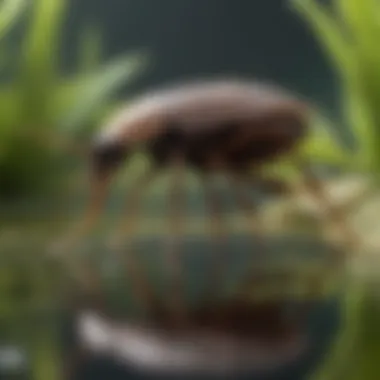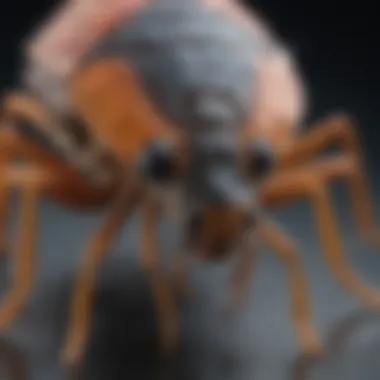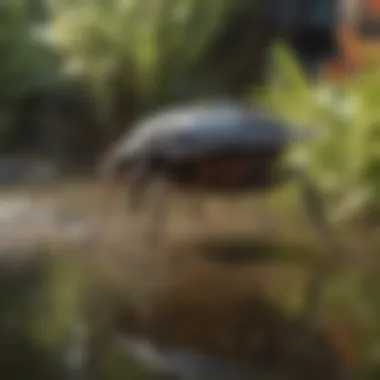Understanding Water Bugs: Biology and Control


Intro
Water bugs are not often a welcome sight in residential spaces. Their presence can evoke unnecessary fear and concern in homeowners, yet understanding these insects can demystify their behavior and biology. This article will explore water bugs, enabling homeowners to mitigate their impact and learn preventive measures.
Understanding Pests
Definition of Pests
In the context of residential environments, pests are organisms that are harmful or irritating to human beings. They can include insects, rodents, or other creatures that invade homes, disrupt daily activities, and even damage property.
Importance of Pest Identification
Identifying pests correctly is critical for effective management. For instance, water bugs, specifically members of the family Belostomatidae, can be easily confused with other insects. Knowing their specific features and behaviors assists in determining an appropriate response. This knowledge helps alleviate alarm and paves the way for realistic strategies to cope with any infestation.
Prevention Techniques
Home and Garden Preventative Measures
Preventing water bugs from entering the home requires a comprehensive approach. Here are some effective measures:
- Seal Cracks: Inspect windows, doors, and any gaps around pipes to ensure they are properly sealed.
- Remove Standing Water: Water bugs thrive in moist environments. Eliminating standing water in gardens, pots, and basements can deter them.
- Maintain Cleanliness: Regularly clean areas such as kitchens, where food and moisture attract pests.
Seasonal Prevention Tips
Understanding pests often relate to seasonal cycles. During warmer months, water bugs may seek refuge indoors. To combat this,
- Monitor Entry Points: Keep an eye on doors and windows for any breaches.
- Adjust Garden Design: Consider shifting garden landscaping to incorporate drier areas that do not encourage water accumulation.
Eco-Friendly Pest Control Solutions
Overview of Sustainable Practices
With growing concerns over chemical pest control, eco-friendly options are becoming more popular. Sustainable practices not only help in controlling pests but also protect the environment. They emphasize natural ecosystems and use advanced pest distribution data.
Natural Remedies and Their Effectiveness
Natural remedies can also be effective for managing water bugs. Some options include:
- Diatomaceous Earth: This powder can deter water bugs if sprinkled around entry points. It is non-toxic to humans and pets.
- Essential Oils: Mixtures of oils like peppermint or tea tree can repel insects when used as sprays.
"Understanding the specifics of pests like water bugs allows homeowners to act with confidence and reduce unnecessary alarm."
Learning about water bugs and their behaviors will empower homeowners. Implementing the suggested prevention techniques and opting for eco-friendly control measures ensures that a home remains a sanctuary, free from disruptions caused by unwanted pests.
Prelude to Water Bugs
Water bugs are often perceived as unwelcome intruders in residential settings. However, understanding them is key to managing their presence effectively. This section explores why water bugs are significant, particularly for homeowners and housewives who may face these critters in their spaces.
Firstly, an informed perspective on water bugs can reduce unnecessary panic. Many individuals react strongly to seeing these insects, but not all water bugs pose substantial risks. By recognizing their characteristics and behaviors, it becomes easier to discern their impact on daily life. Moreover, knowing what attracts these insects can aid in prevention and control, ultimately leading to a healthier living environment.
In essence, understanding water bugs provides crucial benefits that include improved household hygiene, enhanced peace of mind, and informed responses when they are encountered. With this foundational knowledge, residents can approach the issue more pragmatically.


Definition and Identification
Water bugs refer to various species of aquatic insects, including the common Belostoma and Lethocerus genera, which belong to the family Notonectidae. They are characterized by a flat body, long legs, and antennae that provide tactile cues in murky water. Typically, water bugs range from one to four inches in length and possess a distinct appearance, often confused with other pests.
To identify water bugs, it is important to note their physical features. They have a broad, oval-shaped body, somewhat flattened, aiding in their swimming actions. Their legs are long and spread out, ideal for gliding through water. The coloration usually consists of shades of brown or green, enabling them to blend well in their aquatic habitat. Their presence in or near water sources like ponds, lakes, or even in household spaces like basements could be an indicator of an infestation.
Common Species Found in Homes
Various water bug species can find their way into homes, and awareness of these species can assist in identification and control. Common ones include:
- The Giant Water Bug (Lethocerus americanus): This species can grow up to four inches long. Often found in freshwater environments, they can accidentally find their way into homes during heavy rain or flooding.
- The Toe-Biter (Belostoma flumineum): Notable for its painful bite, this species is recognized by its robust body and aggressive behavior. It typically lurks in shallow waters and is often found near gardens or basements during wet seasons.
- The Backswimmer (Notonecta undulata): Unlike most water bugs, backswimmers are easily recognizable due to their unique swimming style. They swim upside down and are much smaller, about one inch long.
These common species, while often alarming to homeowners, play a role in the ecosystem as natural pest controllers.
In summary, understanding the definition, identification, and common species of water bugs can help residents deal more effectively with these insects if they appear in their homes.
Biology of Water Bugs
Understanding the biology of water bugs is crucial for homeowners aiming to manage these pests effectively. Knowledge about their biological features helps in identification and understanding their behavior and habits. This information can guide effective prevention strategies and control measures. Moreover, comprehension of their life cycle assists in determining the right timing for interventions, increasing the efficacy of pest management efforts.
Physical Characteristics
Water bugs, particularly those belonging to the family Belostomatidae, exhibit distinct physical traits. These species are usually large, ranging from 1 to 4 inches in length. Their bodies are flattened and oval, adapting well to life in aquatic environments. The coloration tends to be muted, featuring shades of brown and green that provide camouflage against natural habitats such as pond beds and muddy areas.
The head of a water bug is equipped with prominent compound eyes which are advantageous for spotting potential predators while they swim. They possess powerful forelegs primarily designed for capturing prey, making them efficient hunters. The hind legs are long and paddle-like, facilitating swift movement through water. This combination of features makes them particularly adept at navigating their environment, giving them the ability to thrive both in water and on land when necessary.
Attention to these physical characteristics enables homeowners to distinguish water bugs from more benign insects, reducing the likelihood of misidentification. Understanding their morphology is the first step in tackling any infestation effectively.
Life Cycle and Behavior
Water bugs undergo a simple metamorphosis, characterized by three life stages: egg, nymph, and adult. The life cycle starts when a female lays eggs, usually on submerged vegetation. The eggs hatch, producing nymphs that closely resemble adults but are smaller in size and lack wings. These nymphs are voracious predators and will shed their exoskeletons several times, maturing into adults.
Nymphs are notable for their aggressive behavior. They hunt aquatic insects and small fish, using their strong forelegs to seize prey. As they develop, they become more solitary, often seeking refuge in debris or between rocks. As adults, water bugs maintain their predatory behavior, but they also become more mobile. They can travel to find new sources of food and suitable breeding grounds, especially when conditions in their initial habitats become unfavorable.
Water bugs are usually nocturnal, which means they are most active at night. This behavior affects their visibility to homeowners, who may only see them when they venture into living spaces searching for food or water.
Understanding the life cycle and behavior of water bugs informs effective management strategies, allowing users to target the right stages for treatment.
Overall, knowledge of the biology of water bugs forms a foundation for effective responses to infestations. By recognizing their physical traits and understanding their life cycle, homeowners can implement informed strategies for managing and controlling these uninvited guests.
Why Water Bugs Enter Homes
Understanding why water bugs enter homes is crucial for homeowners. It provides insight into the behavior of these insects and allows for better prevention strategies. Knowing the underlying factors can help alleviate unnecessary panic and allow individuals to take action to minimize their presence in living spaces.
Environmental Factors
Water bugs, especially those of the Belostomatidae family, are drawn to specific environmental conditions. These include warm temperatures and sources of standing water. Areas with stagnant water are prime breeding grounds. Ponds, lakes, and even poorly drained backyards can attract these insects. When they find favorable conditions, water bugs are likely to migrate toward homes in search of food and shelter.
The importance of maintaining your property's exterior cannot be overstated. Overgrown vegetation, debris, and inadequate drainage systems create an environment conducive to water bugs. By managing these aspects, homeowners can decrease the likelihood of these insects entering their homes. Regular inspections of the perimeter of the house and outdoor spaces can reveal problem areas that need attention.
Attractants in Residential Areas
Various attractants exist in residential areas which can lure water bugs. One notable factor is excess moisture. Leaky faucets, humid basements, or any area where water collects can become a magnet for these pests. Additionally, water bugs are also attracted to food sources. Household refuse, stored pet food, or even insects that may inhabit homes can provide sustenance for them.


"Proper waste management can significantly diminish food accessibility for numerous pests, including water bugs."
Homeowners should be vigilant about cleaning up food spills and securing trash bins. Ensuring that bins are tightly sealed and regularly emptied can cut off a crucial resource for water bugs. Furthermore, adding dehumidifiers in damp areas can help reduce moisture levels, making these zones less inviting.
In summary, knowing the environmental factors and attractants that draw water bugs to homes is critical for effective preventive measures. By creating an environment that is less hospitable to these insects, homeowners can potentially avoid infestations altogether.
The Impact of Water Bugs
The presence of water bugs in a home often raises concerns for residents. Understanding their impact is critical to addressing these worries effectively. The significance of this topic intertwines with the potential health risks and property damage associated with these pests. These factors can influence the quality of life within a residence, affecting not only physical space but also mental peace. It is essential to explore both the health risks and the property damage that water bugs can cause.
Health Risks and Concerns
Water bugs, although not directly harmful like some other pests, can still introduce health risks into the home environment. These insects may transmit disease-causing pathogens, primarily through their feces, which can contaminate food and surfaces. The main health risks include:
- Bacterial Contamination: Water bugs can carry bacteria that may lead to foodborne illnesses. If they manage to access kitchens or food storage areas, they can leave behind waste that contaminates food.
- Allergic Reactions: Some individuals may exhibit allergic reactions to the presence of water bugs. Their bodies may react negatively to droppings, shed parts, and other debris, leading to respiratory issues or skin irritations.
It is important to realize that while water bugs are not likely to bite or sting, their presence can still lead to heightened anxiety and concern regarding the overall cleanliness of a home. Keeping areas where food is prepared clean can minimize potential risks.
Damage to the Property
Beyond health implications, water bugs can also cause damage to properties. Their behavior and habitat preferences make them likely to gravitate towards damp areas of a residence. Common types of damage associated with water bugs include:
- Structural Damage: Water bugs often nest in basements, pipes, and around foundation areas where moisture accumulates. Their constant movement and nesting can weaken structures over time, leading to costly repairs.
- Cosmetic Damage: Water bugs can also leave signs of their presence, like stained or soiled surfaces. Their waste and discarded exoskeletons can create an unclean aesthetic, necessitating more frequent cleaning and maintenance.
Understanding these impacts can motivate homeowners to take preventive actions. Regular inspections and maintenance can help keep water bugs at bay, protecting both health and property.
Preventative Measures
The section on preventative measures is crucial for understanding how to keep water bugs at bay. These measures not only reduce the likelihood of an infestation but also ensure a healthier living environment. It’s vital to approach this topic with an awareness of the specific actions that can deter these insects from entering homes. The benefits of implementing preventative measures include enhanced peace of mind, fewer pest control interventions, and lower costs in the long run.
Eliminating Attractants
To effectively prevent water bugs from entering your home, eliminating attractants is essential. Water bugs are drawn to specific conditions that favor their survival.
Some common attractants include:
- Standing water: Moisture retention in basements or overwatering plants creates optimal conditions.
- Food sources: Food left uncovered can attract insects.
- Debris and clutter: Piles of leaves or other organic matter in proximity to the house.
By addressing these factors, homeowners can significantly reduce the chance of an infestation. Mindful practices such as cleaning up spills promptly and ensuring proper trash disposal go a long way in making a home less inviting for these pests.
Home Maintenance Practices
Regular home maintenance practices contribute greatly to preventing water bugs. Two key areas of focus are sealing entry points and proper drainage solutions.
Sealing Entry Points
Sealing entry points is a critical measure in preventing water bugs. Gaps around windows, doors, and pipes are common entry spots. Closing these openings stops bugs from easily accessing living spaces.
One key characteristic of sealing entry points is its efficiency. It is not very costly and can be done via simple methods such as using caulk or weather stripping. The unique feature is that it ensures a physical barrier, making it an effective choice for homeowners since it also prevents other pests.
The advantages of this method include:
- Cost-effectiveness: Simple materials usually suffice.
- Long-term prevention: Once sealed, it prevents not just water bugs but other insects too.
- Ease of implementation: Many homeowners can do this themselves.
However, a potential disadvantage is that homeowners need to be diligent when checking for new gaps that may appear over time.
Proper Drainage Solutions
Another significant aspect is ensuring proper drainage around the home.
Water bugs thrive in damp conditions. Thus, efficient drainage systems that channel water away from the foundation are vital. A critical characteristic of proper drainage solutions is their ability to minimize moisture accumulation. This can be achieved through installing gutters, downspouts, and drainage ditches. The unique feature of these solutions lies in their role in promoting a dry environment, significantly lowering the appeal to water bugs.
Advantages include:


- Reduction of breeding grounds: Addressing moisture limits water bug reproduction.
- Protection of home structure: Reduces the risk of water damage.
- Long-lasting results: Effective drainage can provide benefits for years.
The drawback may be the initial investment involved, but the long-term benefits outweigh these costs.
"Preventative measures play a pivotal role in maintaining a pest-free environment. Through diligent action, you can greatly reduce the risks of infestations."
Effective Control Strategies
Effective control strategies are critical when dealing with water bugs in your home. These strategies focus on minimizing the presence of water bugs and addressing infestations effectively. Understanding these methods not only helps eliminate the insects but also prevents future occurrences. This section discusses both chemical and non-chemical approaches to managing these pests, emphasizing their advantages and application in residential spaces.
Chemical Controls
Chemical controls involve using pesticides specifically formulated to eliminate or deter water bugs. These products can be effective in quickly reducing their population within your home. When using chemical options, it is vital to select a product that targets water bugs specifically to avoid harm to non-target species or household pets. Always follow application instructions carefully to ensure safety and effectiveness. Chemicals can provide immediate results but must be used responsibly and as part of a broader pest management strategy.
Non-Chemical Approaches
Non-chemical approaches can also be effective in managing water bugs. These methods focus on physical removal and prevention without relying on chemical substances. Such strategies are often safer for household environments, particularly for families with children or pets.
Traps and Barriers
Traps and barriers serve as a practical way to control water bugs. Traps can catch bugs that are already in your home, reducing their numbers effectively. Barriers can prevent their entry by sealing points where they could enter your living spaces. The key characteristic of traps is their ability to provide immediate results, as they can trap insects shortly after activation. These methods are beneficial because they do not introduce chemicals into your environment. However, while effective, traps require regular monitoring and may not eliminate the source of the infestation.
Natural Predators
Natural predators are another non-chemical approach that can help control water bug populations. Introducing or encouraging animals that feed on water bugs can provide a natural solution to pest issues. For example, certain species of fish and birds eat water bugs, making them a valuable addition to gardens or ponds. The main advantage of using natural predators is that they contribute to the ecosystem’s balance while controlling pest populations. However, this approach might be less immediate in effect when compared to other control methods, and it requires careful consideration of the balance needed in your local environment.
Seeking Professional Help
Understanding when to seek professional help is crucial in dealing with water bugs in your home. Despite initial perceptions, hiring a pest control service can provide significant advantages. Homeowners often underestimate the complexity of pest infestations. These insects may not only cause discomfort but can also lead to health risks and property damage. Engaging with professionals ensures a thorough approach to eradication and prevention.
When to Call an Exterminator
Identifying the right moment to call an exterminator is essential. If you notice a consistent presence of water bugs in your home despite taking preventative measures, it may be time to seek expert help. Here are some indicators that you should consider:
- Frequent Sightings: If water bugs appear regularly and in numbers, it signals a significant issue.
- Inadequate Control: Your attempts to manage the problem through sprays and traps are ineffective.
- Health Concerns: If anyone in your household has allergies or respiratory challenges, it is wise to consult professionals promptly.
- Property Damage: Noticeable damage linked to these pests can impact the structural integrity of your home.
Calling an exterminator can lead to a comprehensive inspection. They can determine the extent of the infestation and offer effective solutions.
Choosing the Right Pest Control Service
Selecting a suitable pest control service can seem overwhelming. However, following a few clear steps can simplify the process:
- Research Local Options: Look for services with experience in dealing specifically with water bugs.
- Check Reviews and Ratings: Platforms like Reddit and Facebook can provide insights from previous customers.
- Assess Credentials: Verify licenses and certifications to ensure the service meets local regulations.
- Inquire About Solutions: Discuss the methods they use, whether chemical or non-chemical, ensuring compatibility with your preferences.
- Get Estimates: Contact at least three services for quotes, which helps in understanding the reasonable pricing for your situation.
Ultimately, choosing the right pest control service can significantly enhance your home’s safety and comfort. Engaging professionals is often a necessary step in dealing with persistent water bug issues.
Epilogue
In this article, we have examined the significance of understanding water bugs and the various aspects related to their presence in homes. Knowledge about these insects is vital for homeowners and housewives for several reasons. First, recognizing the signs of infestation can help in taking timely measures to address potential issues before they escalate. Understanding water bugs' biology, behavior, and attractants makes it easier to implement effective preventative strategies.
Water bugs are often associated with fear and confusion, but they can be managed with the right approach.
Summary of Key Points
- Definition and Biology: Water bugs are aquatic insects that are often mistaken for pests. Recognizing different species is crucial for effective management.
- Attraction Factors: These bugs enter homes mainly due to environmental conditions or food sources. Recognizing these factors allows for better practices in home maintenance.
- Health Risks and Property Damage: While not drastically harmful, water bugs can pose health risks. They can also damage property if left unchecked, emphasizing the need for prompt action.
- Control Strategies: A mixture of chemical and non-chemical control methods can be effective in managing and preventing infestations.
- Professional Help: Knowing when to seek help from exterminators is essential for severe infestations to ensure the most efficient resolution.
Final Thoughts on Water Bug Management
In summary, managing water bugs requires a comprehensive approach. Homeowners should be proactive in implementing preventative measures. Regular home maintenance can reduce their likelihood of entering your living spaces. If these bugs do appear, knowing the right control strategies can help minimize their impact. Education and prompt action are the best tools for any homeowner facing a water bug issue. By understanding these insects more fully, you can maintain a safe and comfortable home environment.



